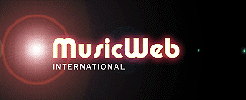Michel van der AA (b. 1970)
Spaces of Blank (2007) [27:08]
Mask (2006) [13:50]
Imprint (2005) [14:10]
Christianne Stotijn (mezzo: Blank)
Gottfried von der Goltz (violin: Imprint)
the Asko|Schönberg Ensemble/Otto Tausk (Mask)
Royal Concertgebouw Orchestra/Ed Spanjaard (Blank)
Freiburg Baroque Orchestra (Imprint)
rec. 20 March, 2009, Concertgebouw, Amsterdam, Netherlands (Blank); 3 July,
2010, Muziekgebouw aan't IJ, Amsterdam, Netherlands (Mask); 3 June, 2006,
Muziekgebouw aan't IJ, Amsterdam, Netherlands (Imprint). DDD
DISQUIET MEDIA DQM01 [55:08]
Michel Van der Aa's music is exciting, innovative, evocatively beautiful and
accessible. It's also highly experimental and often starts from abstract conceptions.
Yet on the evidence of this CD (and the Here Trilogy also reviewed
recently on MusicWeb International) at least it's always highly musical and
engaging. Strangely unassuming, unobtrusive, undemonstrative, it's also music
(and a musical milieu) of real significance to new music and its wider
concerns.
In 2010 the Dutch composer, who is also a multimedia director, founded the
label, Disquiet Media http://disquietmedia.net/
to further and promote the many meeting points between multimedia, music and
the arts emphatically in the context of the most forward-thinking recent developments
in technology. This disc appears on that label. Its production standards,
aesthetics and technical quality are every bit as impressive as Van der Aa's
music.
Spaces of Blank is a collection of three recent works. They all exhibit
those characteristics: Van der Aa's is music about music, his works examine
humans' reactions to and perceptions of music. But this is not impossibly
vague or discursive self-indulgence. Each of the three pieces here looks at
and progressively explores the construction of sound itself. And the ways
in which relationships work between makers, players and listeners. As the
clear and helpful liner-notes put it, 'Van der Aa imperceptibly transforms
acoustic sounds into electronic ones, or manipulates them beyond recognition
by electronic means, thus creating a sound universe that arouses a permanent
state of wonder: what am I hearing, what is meant by this?'
In practice this means providing some of the answers to the questions about
communication and identity as we listen to others' (the composer's, the players')
conception of music. The confluence of a Baroque orchestra (the Freiburg Baroque
Orchestra in Imprint), for example, with musical idioms of 2005 is
an exciting prospect. And it's one that fulfils the promise of that examination
of our conception of music well. Imprint carefully opens up for examination
the role of electronics, which transforms familiar sounds into, not puzzling,
but certainly stimulating ones; the inversion of conventional violin and other
instrumental timbres throughout - not to shock, nor scarcely to provoke. But
to invite us to re-examine how we hear.
Then in the case of Spaces of Blank the invocation of poetry (by Emily
Dickinson, Anne Carson and Rozalie Hirs) works in such a way that the standard
three-movement song-cycle is almost subverted by the complement of electronics
and mechanical commentary on the soundtrack. Yet not as intrusions, still
less self-conscious, or spurious noise for its own sake.
Van der Aa writes, perhaps, as Stravinsky would write were he alive today
- with a touch more apparent restraint. As if the earlier composer had internalised
and rationalised the phlegmatic qualities of his more bravura attachments
to sound. For Van der Aa's is a supremely confident style. He sees no need
to shout. Yet he shares Stravinsky's fascination with fragmentation and sequence;
though the later's music is not scored for the same spectacular impact as
was that of the earlier. Van der Aa impresses by doing much with little.
It's insistent, melodic and concentrated, rather than speculative or tentative
music. There's next to nothing that's spare. The performers are intent on
pulling the most out of the rich sound-worlds; but never have to squeeze.
Van der Aa's is music that yields its substance readily and without fuss -
for all its depths and variety. These are works for intimate orchestra, soloists
(Christianne Stotijn (mezzo) in Spaces of Blank; Gottfried von der
Goltz (violin) in Imprint) and ensemble, the Asko|Schönberg in Mask.
In all three cases the momentum never once lapses, the sense of purpose is
never abandoned, however much the music can be considered exploratory.
Spaces of Blank (from 2007) is the longest work on this CD - at nearly
half an hour. Commissioned by the Royal Concertgebouw Orchestra, it
concentrates more on imagination than exposition - almost as some of Britten's
song-cycles do; anxiety and illusion are not only firmly embedded as subject
matter. They comprise the music's own substance and style. The soprano shares
with her counterparts in the opera, One, and the Here Trilogy
that almost sublime, certainly near-resigned, self-awareness that allows her
to observe her own suffering. The solitude is detached. Here the question
is, Why and How can someone in this state treat herself as a case for study
and neither pity nor regret? The music is accordingly demonstrative without
indulgence.
Mask (2006) lasts almost half as long. It also makes use of electronics
and sound-track. Conflict is present though not as a dramatic theme begging
resolution; rather a model with which to examine perception, deception even.
This requires a mix of real imagination that's played with as much care as
flair. Success on both counts here.
Imprint (2005) is also nearly a quarter of an hour duration. It explores
the relationship between the almost mechanical regularity expected of certain
facets of Baroque music and the apparently incongruous spontaneity of instrumental
intensity which, in this case, violinist Gottfried von der Goltz, conveys
very well.
This is a CD to approach head-on. Repeated listening reveals more of substance
each time. The playing is uniformly excellent. If the name is new to you,
try and supplement the compelling music on this CD with a little background.
His is a project that's certainly going places.
Mark Sealey
Another excellent and excellently-produced CD from Van der Aa's Disquiet label.
He's a composer much in demand at present. Listen to this interesting and
convincing music to see why.
